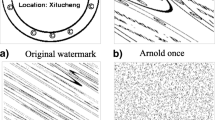Abstract
Today, digital content distribution is already common practice for media types like audio. It is expected that in the near future, systems like Video-on-Demand will also increase in popularity. Many Digital Right Management (DRM) models exist enforcing the copyrights associated with the distributed content. We argue that a simplified model based on so-called forensic watermarks is a viable alternative approach that closely mimics the current model of physical music and video distribution by providing a reasonable compromise between the conflicting interests of consumers and content owners. In this paper, we address the forensic watermark DRM model and introduce a generalized architecture for the distribution server and the forensic watermark tracker. In this model, important attack scenarios are identified as being the ‘copy attack’ and the watermark ‘rendering’. We show that it is more difficult to successfully work out these attack scenarios by (i) integrating a content identification and watermarking system and (ii) making the watermark (both the carrier signal as well as the payload) content dependent. In addition to these security aspects, we also focus on efficiency of the distribution server. By separating the computational efforts in so-called pre-coding and on-line computational phases, the required signal processing resources of the distribution server can be reduced significantly. The general architecture including security and efficiency requirements are analyzed in a practical example of Electronic Music Delivery (EMD). We show that computational complexity can be reduced up to a factor 4 compared to a straightforward approach. In practice, it means that with current state-of-the art computers (Pentium IV, 1 GHz) watermark embedding speeds of about 40 times Real Time (RT) can be achieved. In addition to the embedding architecture, we also demonstrate an efficient method for detecting watermarks in a forensic watermark tracker. Having multimedia identification fingerprints available (required for working with content-dependent watermarks), the efficiency of watermark detection can be enhanced by using them as side information. Again, in our EMD prototype, we demonstrate that (depending on the parameter settings) the detector can run up to 50 times faster than a blind detector, in which the original or the fingerprint is not available.
Similar content being viewed by others
References
Arnold, M., Huang, Z.: Fast audio watermarking concepts and realizations. Electronic Imaging 2004, Security and Watermarking of Multimedia Content VI. San Jose, USA (2004)
Becker, E., Buhse, W., Günnewig, D., Rump, N. (eds.): Digital Rights Management: Technological, Economic, Legal and Political Aspects. Springer-Verlag, Berlin (2003)
Cardellini, V., Casalicchio, E., Colajanni, M., Yu, P.S.: The state of the art in locally distributed web server systems. ACM Comput. Surv. 34(2), 263–311 (2002)
Crowcroft, J., Perkins, C., Brown, I.: A method and apparatus for generating multiple watermarked copies of an information signal. WO patent 00/56059 (2000)
Czerwinski, S., Fromm, R., Hodes, T.: Digital music distribution and audio watermarking. UCB IS 219, project report (1999)
Degroot, M.H.: Probability and Statistics. Addison-Wesely (1986)
Haitsma, J., Kalker, A.A.C.: A highly-robust audio fingerprinting system with efficient search strategy. In: 3rd International Conference on Music Information Retrieval, Paris, France (2002)
ITU-R Rec. BS.1116-1: Methods for the subjective assessment of small impairments in audio systems including multichannel sound systems. In: International Telecommunications Union, Geneva, Switzerland (1997)
Jonker, W., Linnartz, J.: Digital rights management in consumer electronics products. Special Issue on digital rights management. IEEE Signal Process. Mag. 21(2), 82–91 (2004)
Kutter, M., Voloshynovskiy, S., Herrigel, A.: The watermark copy attack, Electronic Imaging 2000, Security and Watermarking of Multimedia Content II, San Jose, USA (2000)
Lemma, A.N., Aprea, J., Oomen, W., van de Kerkhof, L.: A temporal domain audio watermarking technique. IEEE Trans. SP 51(4), 1088–1097 (2003)
Parviainen, R., Parnes, P.: Large scale distributed watermarking of multicast through encryption. In: Steinmetz, R., Dittman, J., Steinebach, M. (eds.) Communications and Multimedia Security Issues of the New Century, pp. 149–158 (2001)
Soulodre, G.A., Grusec, T., Lavoie, M., Thibault, L.: Subjective evaluation of state-of-the-art 2-channel audio codecs. In: The 104th AES Convention, Amsterdam, The Netherlands, pp. 4740 (P11-5) (May 1998)
Steinebach, M., Zmudzinski, S., Chen, F.: The digital watermarking container: secure and efficient embedding. In: Proceedings of the Multimedia and Security Workshop, Magdeburg, Germany (2004)
van der Veen, M., Lemma, A., Bruekers, F., Kalker, T., Aprea, J.: Security issues in digital audio watermarking. In: European Signal Processing Conference (EUSIPCO). Toulouse, France (2002)
van der Veen, M., Lemma, A., Kalker, T.: Watermarking and fingerprinting for electronic music delivery. Electronic Imaging 2004, Security and Watermarking of Multimedia Content VI. San Jose, USA (2004)
Author information
Authors and Affiliations
Corresponding author
Rights and permissions
About this article
Cite this article
der Veen, M.v., Lemma, A.N. & Kalker, T. Electronic content delivery and forensic watermarking. Multimedia Systems 11, 174–184 (2005). https://doi.org/10.1007/s00530-005-0200-9
Published:
Issue Date:
DOI: https://doi.org/10.1007/s00530-005-0200-9




